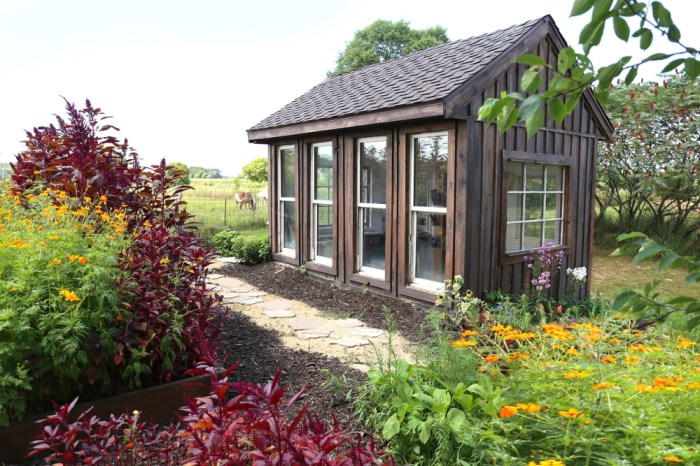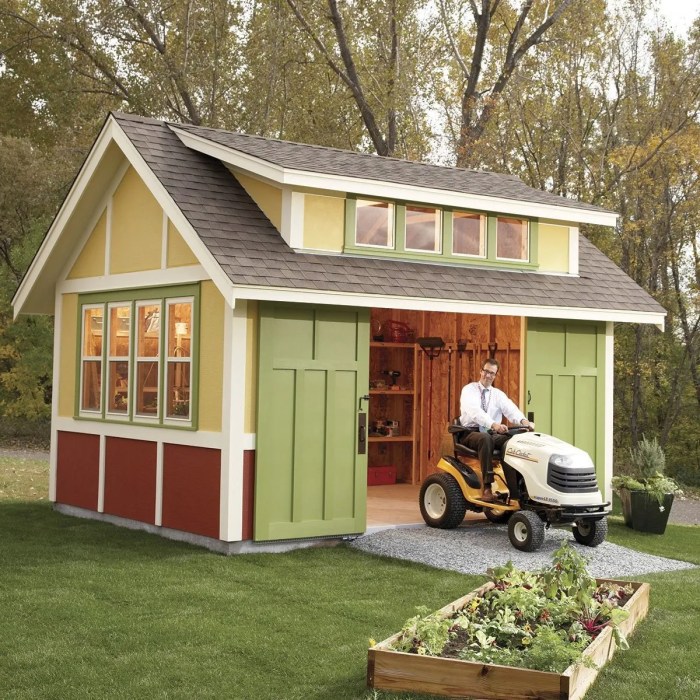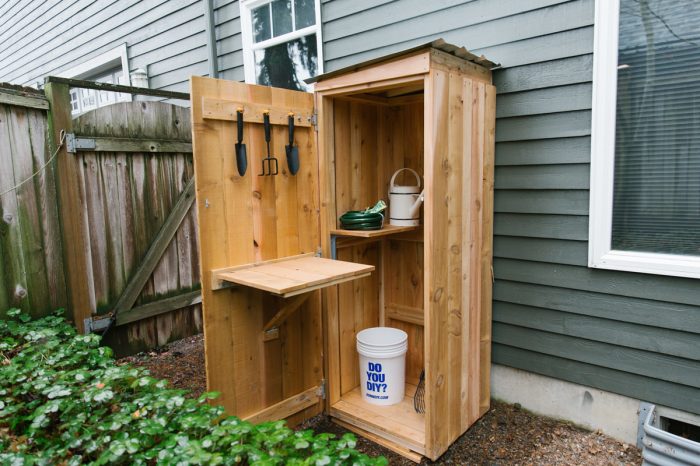DIY garden shed ideas set the stage for this enthralling narrative, offering readers a glimpse into a story that is rich in detail and brimming with originality from the outset. Building your own garden shed can be a rewarding and fulfilling project, allowing you to create a personalized space for storage, hobbies, or simply enjoying the tranquility of your outdoor surroundings. Whether you’re a seasoned DIYer or a novice builder, this guide will provide you with the knowledge and inspiration to bring your dream shed to life.
Table of Contents
From planning the perfect location and size to selecting the right materials and tackling the construction process, we’ll cover every aspect of building your own garden shed. We’ll explore various design options, including unique features and space-saving solutions for smaller yards. We’ll also discuss the importance of safety, regulations, and sustainability, ensuring that your shed is both functional and environmentally responsible.
Planning Your Garden Shed

Before you start building your garden shed, it’s crucial to carefully plan its purpose, size, location, and layout. This ensures that your shed meets your needs and complements your garden.
Determining the Purpose and Use
The purpose of your shed will determine its size, features, and layout. Consider what you plan to store in the shed, whether you’ll be using it as a workshop, or if you need space for gardening equipment, tools, and supplies.
Doors and Windows: Diy Garden Shed Ideas

Doors and windows are essential components of any garden shed, providing access, security, and natural light. They can also significantly impact the shed’s overall aesthetics and functionality. This section will guide you through the design and installation process for both doors and windows.
Designing and Installing a Door
The door is the primary access point to your shed, so it’s crucial to choose the right size, style, and security features.
- Size: Consider the dimensions of your shed and the items you’ll be storing. A standard single door, approximately 30 inches wide, is sufficient for most sheds. If you need to store larger items, consider a double door or a wider single door.
- Style: Choose a door style that complements your shed’s design and suits your needs. Common options include:
- Single-swing doors: The most common and cost-effective option.
- Double-swing doors: Offer wider access for larger items.
- Sliding doors: Save space and are ideal for sheds with limited side clearance.
- French doors: Add a touch of elegance and provide a wider opening.
- Security: Consider the level of security you need for your shed. Options include:
- Standard door hardware: Includes a simple knob or lever handle with a deadbolt.
- Reinforced door frames: Provide additional strength and deter forced entry.
- Security door hinges: Prevent the door from being easily removed.
- Security locks: Offer extra protection against unauthorized access.
When installing a door, ensure it’s properly aligned and functional. Here are some tips:
- Use a level to ensure the door frame is plumb and square.
- Install the hinges securely and adjust them for proper door swing.
- Secure the door handle and deadbolt with appropriate screws.
- Check the door’s clearance for smooth operation.
Choosing and Installing Windows
Windows provide natural light and ventilation, enhancing the shed’s functionality and aesthetics. Consider the following factors when choosing windows:
- Size: Determine the amount of natural light you need and the space available for windows. Small windows can provide adequate light and ventilation for smaller sheds, while larger windows are better for larger sheds or those requiring more light.
- Style: There are various window styles available, including:
- Single-hung windows: The most common type, with a sash that slides up and down.
- Double-hung windows: Both sashes slide up and down, offering more ventilation.
- Casement windows: Open outward with a crank handle, providing excellent ventilation.
- Awning windows: Hinge at the top and open outward, offering protection from rain.
- Material: Choose a material that complements your shed’s design and meets your budget. Common options include:
- Vinyl windows: Durable, low-maintenance, and affordable.
- Wood windows: Offer a classic look but require more maintenance.
- Aluminum windows: Lightweight, durable, and require minimal maintenance.
Installing windows requires careful attention to sealing and weatherproofing to prevent leaks and drafts. Here are some steps:
- Cut the window opening to the exact size of the window frame.
- Use a level to ensure the window frame is plumb and square.
- Secure the window frame to the shed wall using screws or nails.
- Apply a sealant around the window frame to prevent leaks.
- Install the window sash and hardware.
- Check the window’s operation and adjust the hardware as needed.
Building a Garden Shed on a Budget
Building a garden shed can be a rewarding project, but it doesn’t have to break the bank. With careful planning and some clever strategies, you can create a functional and stylish shed without sacrificing your budget.
Saving Money on Materials
There are several ways to save money on materials for your garden shed.
- Shop around for the best deals. Compare prices from different retailers, both online and in-store. Consider visiting lumberyards or building supply stores for potential discounts on surplus materials.
- Choose affordable materials. While premium woods like cedar or redwood are durable, they can be expensive. Consider using pressure-treated pine or spruce for the framing and siding, which are more budget-friendly and still offer good resistance to moisture and rot.
- Buy in bulk. Purchasing materials in bulk can often result in significant savings, especially for items like plywood, screws, and nails.
- Consider using recycled or repurposed materials. Old pallets, reclaimed wood, and salvaged windows can be incorporated into your shed design, adding character and saving money.
Saving Money on Labor
- Do as much of the work yourself as possible. While hiring a contractor can save time, it will also increase your costs. If you have some basic carpentry skills, you can tackle many of the construction tasks yourself.
- Enlist help from friends or family. Having extra hands on deck can make the project go faster and can also be a fun way to spend time with loved ones.
- Plan ahead and avoid costly mistakes. Taking the time to carefully plan your shed design and gather all the necessary materials before starting construction can help you avoid costly errors and rework.
Affordable Building Materials and Alternatives, Diy garden shed ideas
- Pressure-treated lumber: This is a cost-effective choice for framing and siding, as it resists rot and moisture damage.
- Plywood: For sheathing and roof decking, plywood is a versatile and affordable option.
- Vinyl siding: While not as traditional as wood, vinyl siding is durable, low-maintenance, and relatively inexpensive.
- Metal roofing: Metal roofing is a long-lasting and low-maintenance alternative to asphalt shingles, although it can be more expensive upfront.
- Reclaimed materials: Old pallets, salvaged windows, and reclaimed lumber can be incorporated into your shed design to add character and save money.
DIY Techniques and Tools to Minimize Costs
- Learn basic carpentry skills. Many online resources and books can teach you the fundamentals of building a shed.
- Invest in essential tools. A basic set of tools, including a saw, hammer, drill, and level, will be essential for most construction tasks.
- Use hand tools whenever possible. While power tools can be faster, hand tools are often more affordable and can be just as effective.
- Plan your cuts carefully to minimize waste. Take the time to measure and mark your materials accurately before cutting to reduce the amount of leftover wood.
Repurposing Materials for the Shed
- Old pallets: Pallets can be disassembled and used for framing, siding, or even shelving.
- Reclaimed wood: Old barn wood, salvaged lumber, or even discarded furniture can be repurposed for unique and budget-friendly shed features.
- Salvaged windows: Find old windows at salvage yards or flea markets to add natural light and character to your shed.
Safety and Regulations

Building a garden shed is a rewarding project, but safety should always be your top priority. Not only do you need to ensure your own safety, but also the safety of anyone else who might be involved in the project. Additionally, you need to be aware of local building codes and regulations to ensure your shed is built to standards and legal requirements.
Local Building Codes and Regulations
Local building codes and regulations are designed to ensure that structures are safe, stable, and meet minimum standards. These codes vary by location, so it’s crucial to research and understand the specific regulations in your area. For example, you may need to obtain a permit before starting construction, and your shed may need to meet specific requirements regarding its size, location, and materials.
Obtaining Necessary Permits and Inspections
The process for obtaining permits and inspections can vary depending on your location. It’s recommended to contact your local building department to inquire about the specific requirements for your project. Generally, you will need to submit plans for your shed, which may include details about its dimensions, materials, and foundation. Once your plans are approved, you will likely need to obtain a permit to start construction. Inspections may be required at different stages of construction, such as during foundation work, framing, and final completion.
Safety Checklist for Shed Construction
Before you start building your shed, it’s essential to have a safety checklist to ensure you’re taking the necessary precautions.
- Clear the Construction Area: Remove any obstacles, such as trees, rocks, or debris, from the construction site. This will help to prevent accidents and ensure a safe working environment.
- Use Proper Tools and Equipment: Ensure all tools and equipment are in good working order and use them safely. This includes using appropriate safety gear, such as gloves, eye protection, and hearing protection.
- Follow Manufacturer Instructions: Carefully read and follow the manufacturer’s instructions for all tools, equipment, and materials used in construction.
- Work with a Partner: It’s always a good idea to have a partner help with lifting heavy objects and performing tasks that require two people. This can help to prevent accidents and ensure everyone’s safety.
- Inspect Regularly: Regularly inspect the construction site for any potential hazards, such as loose materials, uneven ground, or exposed wires. Take steps to correct any issues promptly.
- Keep the Construction Area Clean: Regularly clean up debris and tools to prevent tripping hazards and maintain a safe working environment.
- Use Proper Lifting Techniques: When lifting heavy objects, use proper lifting techniques to avoid injury. Bend your knees, keep your back straight, and lift with your legs, not your back.
- Beware of Power Lines: Always be aware of overhead power lines and avoid working near them. If you need to work near power lines, contact your local utility company for guidance.
- First Aid Kit: Keep a well-stocked first aid kit on hand in case of any minor injuries.
- Fire Extinguisher: Have a fire extinguisher readily available in case of a fire.
By following the steps Artikeld in this guide, you’ll be well on your way to building a beautiful and functional garden shed that will enhance your outdoor living space for years to come. Remember, the journey is as rewarding as the destination, so enjoy the process and embrace the satisfaction of creating something truly unique and personal.
Building a DIY garden shed can be a rewarding project, offering a space for tools, gardening supplies, or even a cozy retreat. If you’re looking to enhance your outdoor experience, consider adding a DIY coal grill to your shed. This way, you can enjoy grilling and entertaining right in your own backyard, adding a touch of culinary delight to your garden shed oasis.


